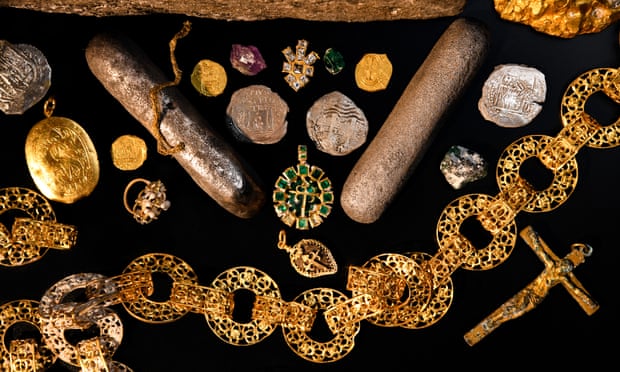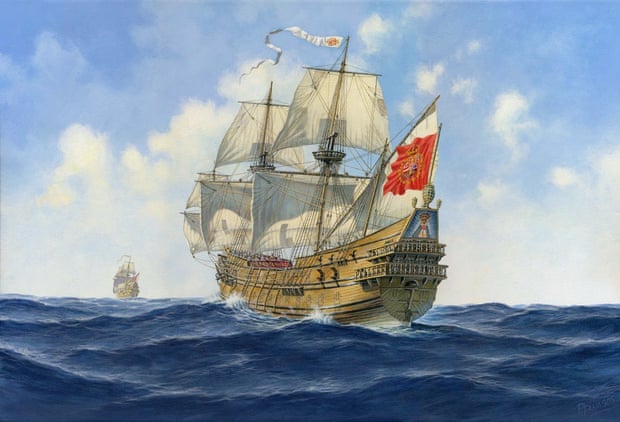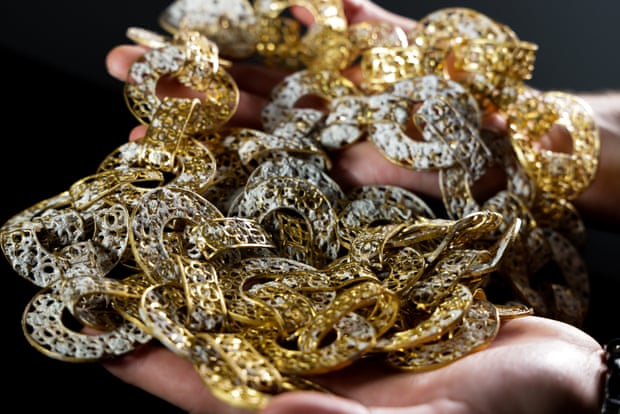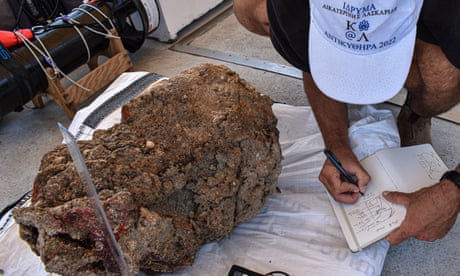Marine archaeologists stunned by priceless cache long hidden beneath the Bahamas’ shark-infested waters

It was a Spanish galleon laden with treasures so sumptuous that its sinking in the Bahamas in 1656 sparked repeated salvage attempts over the next 350 years. So when another expedition was launched recently, few thought that there could be anything left – but exquisite, jewel-encrusted pendants and gold chains are among spectacular finds that have now been recovered, having lain untouched on the seabed for hundreds of years.
The Nuestra Señora de las Maravillas (Our Lady of Wonders) went down on the western side of the Little Bahama Bank, over 70km offshore, but the newly discovered treasures were found across a vast debris trail spanning more than 13km.
Allen Exploration, with Bahamian and US marine archaeologists and divers, was licensed by the Bahamian government to explore the Maravillas scientifically and is committed to displaying the finds in a new museum in the Bahamas.
An elaborate, gold filigree chain, with rosette motifs, is among treasures that suggest some of the discoveries were destined for wealthy aristocrats, if not royalty. A gold pendant bearing the Cross of Santiago (St James) and an Indian bezoar stone, then valued in Europe for its healing properties, is shaped like a scallop shell, the symbol recognised by pilgrims heading for Santiago de Compostela in Galicia. It is among finds linked to the sacred Order of Santiago, a military-religious order of knights, who protected pilgrims and were active in Spain’s maritime trade.
Another pendant features a gold Cross of St. JamesSantiago over a large, green, oval emerald framed by a dozen square emeralds, perhaps symbolising the 12 apostles.
Clusters of emeralds and amethysts mined in Colombia and now recovered offer evidence of contraband trafficking as they were not registered on the manifest.
Dr Sean Kingsley, an English marine archaeologist and editor of Wreckwatch magazine which will feature the finds in a forthcoming issue, told the Observer that such “marvels” are particularly dramatic as they were in the middle of nowhere, under dense sand. “This is successful key-hole archaeological surgery,” he said.
The Maravillas, named after a “miraculous” 13th-century sculpture of the Virgin Mary in a Madrid convent, was part of a fleet. It was heading home to Spain from Havana with treasures from the Americas, both royal and private consignments, as well as contraband and a lavish cargo rescued from another Spanish galleon wrecked off Ecuador.

But at around midnight on 4 January 1656, it sank, following a navigational error in steering clear of shallow waters. Colliding with its fleet flagship, it hit a reef and only 45 of 650 people on board survived. Many were eaten by sharks.
Allen Exploration was founded by Carl Allen, who developed a successful plastics business before retiring early, becoming a philanthropist and explorer with two passions – the Bahamas and its sunken past.
“When we brought up the oval emerald and gold pendant, my breath caught in my throat,” he said. “I feel a greater connection with everyday finds than coins and jewels, but these Santiago finds bridge both worlds. The pendant mesmerises me when I hold it and think about its history. How these tiny pendants survived in these harsh waters, and how we managed to find them, is the miracle of the Maravillas.”
He added: “The wreck of the galleon had a tough history – heavily salvaged by Spanish, English, French, Dutch, Bahamian and American expeditions in the 17th and 18th centuries, and blitzed by salvors from the 1970s to early 1990s. Some say the remains were ground to dust. Using modern technology and hard science, we’re now tracking a long and winding debris trail of finds.”

He was convinced that not all the ship was destroyed and pulled together a team and ships to search for the lost sterncastle, which is thought to have broken away and drifted off. But he wanted to study the wreck archaeologically, unlike his predecessors who did not publish any science, and who simply sold off finds.
His team is using cutting-edge science to work out how the Maravillas was wrecked and then scattered by centuries of hurricanes.
The expedition is also collecting data on the reef health, seafloor geology and plastic pollution to understand how the archaeology and marine environment interact.

“The sea bottom is barren,” said Allen. “The colourful coral that divers remembered from the 70s is gone, poisoned by ocean acidification and choked by metres of shifting sand. It’s painfully sad. Still lying on those dead grey reefs, though, are sparkling finds.”
The team has recorded stone ballast, iron fasteners that once held the hull together, and iron rings and pins from the rigging. Evidence of shipboard dining, from olive jars to Chinese and Mexican plates, and personal belongings, including a soldier’s silver sword-hilt and a pearl ring, have also been found.
All wreckage in Bahamian waters is the property of the government of the Bahamas and Allen Exploration is keeping the finds together by sponsoring the Bahamas Maritime Museum, which opens on 8 August in Freeport.